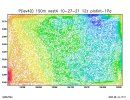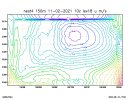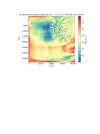Dear WRF Users,
I have been executing WRF-LES simulations using one-way interactive multinesting from mesoscale to LES (150m finest nest) for several months. The model will execute with setting vert_refine_method=2 (vertical nesting) and with hybrid_opt=2 and etac=0.2. Although interior results usually look believable there is always suspicious gradients of the fields that are within or just outside the edges of my lateral boundary buffer zone. I have tried many things to alleviate this in the lateral buffer zone but it is persistent regardless of vertical resolution I throw at it. I now think the issue might be that vertical nesting may not be advisable to use with the hybrid_opt=2 option. Perhaps vertical nesting is designed to work best with hybrid_opt=0 (original terrain following coordinate)? I have noticed others doing WRF-LES with vertical nesting also select hybrid_opt=0 and seem to not have such a boundary zone issue (unless they just do not show these boundary zone results in their analyses and plots). Is there some guidance that cautions about vertical nesting with the hybrid vertical coordinate? Thanks. I am middle of doing a simulation test now to see if this fixes my issue with the lateral boundary zone gradients.
I have been executing WRF-LES simulations using one-way interactive multinesting from mesoscale to LES (150m finest nest) for several months. The model will execute with setting vert_refine_method=2 (vertical nesting) and with hybrid_opt=2 and etac=0.2. Although interior results usually look believable there is always suspicious gradients of the fields that are within or just outside the edges of my lateral boundary buffer zone. I have tried many things to alleviate this in the lateral buffer zone but it is persistent regardless of vertical resolution I throw at it. I now think the issue might be that vertical nesting may not be advisable to use with the hybrid_opt=2 option. Perhaps vertical nesting is designed to work best with hybrid_opt=0 (original terrain following coordinate)? I have noticed others doing WRF-LES with vertical nesting also select hybrid_opt=0 and seem to not have such a boundary zone issue (unless they just do not show these boundary zone results in their analyses and plots). Is there some guidance that cautions about vertical nesting with the hybrid vertical coordinate? Thanks. I am middle of doing a simulation test now to see if this fixes my issue with the lateral boundary zone gradients.







